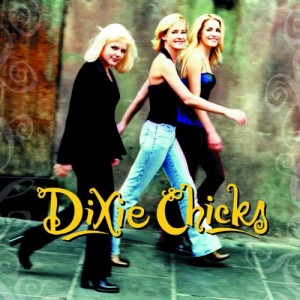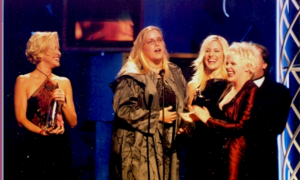It was the title song from the album that would win them their first Grammy.
The title song was non-other “Wide Open Spaces,” by the country band the Dixie Chicks. “Wide Open Spaces” was the third single released from the same title album, and hit number one on the U.S. Country singles, and spent four weeks there in November 1998. Although the title song brought fame to the Chicks, it was popular because of its relatable message to listeners.
The Texas country-bluegrass trio, the Dixie Chicks came to the country music scene in the late 90s. All natives of Texas and passionate about music since youth, the band is composed of founding members and sisters Martie Maguire and Emily Robison, and lead singer Natalie Maines. The sisters began playing instruments at an early age, Martie on the mandolin and fiddle, while Emily played the banjo and dobro.
The sisters originally founded the Dixie Chicks in Dallas in 1989. The sisters along with two other women went around for six years playing in bluegrass music festivals and small venues. After the departure of their lead singer and other band mate, the Erwin sisters were in need of a lead singer. Lylod Maines was playing steel guitar for the Chicks at a gig in Lubbock, Texas; Maines shared a copy of his daughter’s audition tape. The sisters were memorized, and found Natalie Maines as perfect lead singer to complete the Chicks.
In 1997, Sony came to Austin to see the new and improved Dixie Chicks. Sony agreed to sign them, and it was the beginning of the trio’s stardom. Besides the fact these women were musical talented, the trio was fearless in their sound.
Two year later after the Chicks rose to fame, their second studio album “Fly” had the same headstrong message. One song in particular, “Goodbye Earl” that sings about two female friends, one with an abusive husband, and the process of murdering him.
Allen Bulter, President of Sony Nashville, commented in the Texas monthly special issue in September of 1999. Butler said, “Is the label nervous? A little, but I am not going to argue with the success.”
Female artists in the 90s were singing about empowerment. When Sony came to Austin to sign the Chicks, they too had to get their piece in this popular topic. It was three women singing songs about being bold, and within a year under the Sony label the Chicks released both the title track and debut album. The soulful title track and album was monumental for the trio’s career.
At the Grammy’s, the Chicks took home Best Country Album and Best Country Performance by a Duo or Group with Vocal with their other number one single “There’s your Trouble.”
The Texas trio proved they deserved a spot in the country music scene, and the Academy of Country Music named the Dixie Chicks both top and new vocal group of the year in 1998, along with awarding them Album of the year. But the title track and album was more than chart-toppers and awards.
The success of song “Wide Open Spaces” resides in the message it sends to it listeners. “Wide Open Spaces” spoke volumes to millions of young women, encouraging them to, as cliché as it sounds, “spread your wings and fly.” The track, the album, and other songs by the Dixie Chicks spoke on female empowerment and independence, a common theme among other country women like: Faith Hill, Shania Twain, and Martina McBride. And like the Dixie Chicks, they too dominated the charts and award shows in the late 90s.’
However, if it was not for an unknown songwriter, the on the way to fame Dixie Chicks might not have had achieved the same success.
Susan Gibson was the daughter of a piano teacher and railroad worker. Gibson lived all around the United States, but found herself in Amarillo, Texas during her highs school and college years. In an interview with Ace Collins of “Texas Music Magazine” in Fall 2000, Gibson said was a lover of music from an early age, but country music was not on her radar. Women like Tracey Chapman and the Indigo Girls, were musical influences during her teenage years. The love of blues and rock music fostered a desire for Gibson to start writing her own music.
While on winter break from college, Gibson returned home to Amarillo, Texas for the holidays. Although she was always close to her family, all of the sudden, she felt muffled in her own home. There were too many people watching her and giving their two cents. In her own home, Gibson did not have the room to grow.
One night Gibson was looking for solitude. At her kitchen table, Gibson began writing out her feelings in an old notebook. Gibson had no idea she was writing the lyrics to a number one. In her interview with Texas Music Magazine, she recalled the moment at the kitchen table.
“Here I was, thinking I was full of maturity and confidence,” Gibson said, “thinking I knew it all and I was all grown up, Because of my attitude at the time, I felt I needed more elbow room and didn’t want to be at home with the family.”
“It took 20 minutes to write the lyrics that expressed how I really felt at the moment,” Gibson said.
In the book, Women in Texas Music, Gibson reflected on writing “Wide Open Spaces” to author Kathleen Hudson.
“My favorite part about writing “Wide Open Spaces” is that I wrote the song at my mom’s kitchen table,” Gibson said. “When I left, I left my notebook on the table. She found the notebook-so much for doing it all by myself.”
In a care package to her daughter, Gibson’s mother sent the old notebook. When Gibson found received the old notebook, Gibson read the lyrics again. Sure enough, she put them to music.
With a finished song by Gibson, the question remains how did “Wide Open Spaces” get to the Dixie Chicks?
After Gibson decided not to finish her degree, she moved back to Amarillo, Texas. There, she started a band with friends called the Groobees. While trying to expand their fan base past the panhandle of Texas, the Groobees recorded a demo of Gibson’s song to send to Lloyd Maines, who was producing music at the time.
“We sent him [Lloyd Maines] the tape hoping he would get interested in us,” Gibson told Texas Music Magazine. “Lloyd liked my song so much he made a copy for everyone in his family. He even got a demo tape to his daughter Natalie, who just joined the Dixie Chicks.”
At the time, The Dixie Chicks were trying to finish their first album. The trio was going through demo after demo looking for the songs to put on their first big album. If all three liked a demo, they performed it during concerts. Because of the success Gibson’s song had at concerts, “Wide Open Spaces” landed not only a recording on the album, but it became the title track of the trio’s first big album.
In the interview with Ace Collins of Texas Music Magazine, Gibson reflected on what the opportunity was like.
“The song reflected where both of us-the Dixie Chicks and myself-were at that moment. We both needed spaces to grow, to try our wings,” Gibson said.
The closeness of reality “Wide Open Spaces” shared between Gibson and the Dixie Chicks is also shared among listeners. Although the song depicts the main character of the song a female, both males and females can relate to the message. Therefore, to reiterate, the success of this track is in the lyrics, and the empowering message it sends to its listeners.
The songs starts with a fiddle riff, then the rest of the band joins in. The verses are sung by Natalie Maines, with sounds of the drums, fiddle, guitar, and piano, accompany Maines. The opening verse reads,
“Who doesn’t know what I’m talking about
Who’s never left home, who’s never struck out
To find a dream and a life of their own
A place in the clouds, a foundation of stone”
This opening verse itself speaks to listeners because it is so relatable. Although the first two lines of the opening verse are phrased as a question, they catch the listener to tune in. At some point in all of our lives, we all will leave home, a place of comfort and familiarity, to pursue a dream or hope some kind. However, while doing so, they need room or “wide open spaces.”
In a blog titled “Reflections of a Grady Doctor”, doctor Kim Manning wrote in 2012 about her own personal experience to “Wide Open Spaces.” Manning said the opening verse reminded her of friend Angella Lister, whose daughter recently went to college.
“Those words touch me, reminding me that at some point we have to turn our children loose to live their dreams. We hope that we’ve equipped them with a solid sense of self and some kind of road map telling them how to give and receive authentic love. Because that? That’s the foundation of stone that will allow those dreams to come true. Or at least a comeback if a failure is involved,” Manning wrote.
Manning spoke from a maternal perspective. Nevertheless, her point of view recognizes because of the strong foundation that was created from “home,” it will help one to persevere in midst of adversity while on their way to finding their dream.
The choruses feature sisters Emily Erwin and Martie Seidel, backing up Maines with harmony vocals, also a banjo line. The chorus is where listeners will find themselves repeating in their head all day long.
“She needs wide open spaces
Room to make her big mistakes
She needs new faces
She knows the high stakes”
The chorus rings as a declaration of independence, but each individual has their own personal “Wide open spaces”, they yearn to go away from home in order to pursue their dreams. They realize there are risks and mistakes that go along with pursuing their dreams.
Manning addresses the track’s chorus in her blog post, and what it emphasizes.
“I always believed that we all face points in our lives where we need “wide open spaces. Sometimes it’s just a simple redefinition of who we are. Other times it’s a big step like packing up and moving to a completely different place. Those “new faces” can be in the literal sense or in the figurative sense with how we see and interact those around us, ” Manning wrote.
Manning reflection on “Wide Open Spaces” is a testament to how listeners far and wide felt about the number one hit. In between the repeat of the chorus and last verse there is an instrumental break that features Erwin and Seidel on mandolin and fiddle.
The main fiddle riff that opened the song brings the track to a close, leaving the listener to continue humming the tune all day long. More than that, the fiddle at the end gives the opportunity for the listener to take in the message of empowerment.
However, if it was not for a young unknown songwriter desiring for her own “Wide Open Spaces” the Dixie Chicks would not had the success they did on their Grammy winning album.
Works Cited
Fields, Jamie Schilling. “The Dixie Chicks.” The Dixie Chicks (1999): 120+.Http://chickoholic.tripod.com/DixieChicks/Magazine%20Articles/TexasMonthly0016.pdf. Texas Monthly, Sept. 1999. Web. 21 Feb. 2016.
Hudson, Kathleen. Women in Texas Music: Stories and Songs. University of Texas Press, 2007. Print.
Manning, Kim, Dr. “Reflections of a Grady Doctor.” : Music Lyric Monday: Wide Open Spaces. N.p., 15 Oct. 2012. Web.
“Story Behind the Song: Wide Open Spaces.” Interview by Ace Collins. Story Behind the Song: Wide Open Spaces. Texas Music Magazine, Fall 2000. Web. 28 Feb. 2016.


